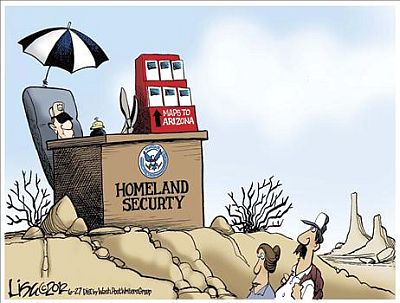Dear friends: I am pleased to bring to you Gerald Celente’s assessment of the threats posed to Internet freedom. Celente’s Trends Journal is one of the most insightful publications of our era. PCR
Do you remember the Safe-Cyber instructions they taught you in the mandatory Computer Ed class (operated by the National Institute of Standards and Technology)? First you fire up your Secured Computing Device (SCD) and its hardware token authenticator.
Then you enter the six-digit algorithmically generated password displayed (a new one flashes every 60 seconds) and are asked to supply your biometric identifier. You place your thumb on the built-in fingerprint pad, click, and wait for the Internet connection to begin. But it doesn’t.
Instead, the screen goes black for a second before the dreaded words appear: “Malware has been detected on this SCD. As mandated by federal law, it has been placed in quarantine.” Then the machine shuts down.
This is not just conjecture, but an imminent scenario. Policies, such as the White House proposed “National Strategy for Trusted Identities in Cyberspace,” which will transform the character, culture and freedom of the Internet, are already in place. The 20 cybersecurity-related bills introduced in the Senate in 2011, and the dozen introduced in the House of Representatives, have wound their way through committees and, according to Senator Harry Reid, are scheduled to be voted on in the first quarter of 2012. Almost all of them, with the blessing of the White House, would make the Department of Homeland Security the overseer of private-sector networks.
Considering the apocalyptic rhetoric coming from Washington and the ranks of cybersecurity experts – echoed by media reports that portray every picayune data breach as Armageddon – it would appear that the vulnerability of the Internet has been underplayed for many years.
In the Internet’s start-up decades, both industry and government were committed to establishing an atmosphere of trust that would draw the public into conducting more and more digital business. Though data breaches, theft of trade secrets, identity theft and bank robbery have been a fact of Internet life since its beginnings, there were few laws requiring disclosure. Banks and credit card firms ate their losses as a cost of doing business, and the giant corporations kept mum rather than roil the public. Recently, the pendulum has swung in the other direction and a raucous alarm has been sounded regarding the great danger posed by the Internet.
The Nation is at a crossroads. The globally-interconnected digital information and communications infrastructure known as “cyberspace” underpins almost every facet of modern society and provides critical support for the U.S. economy, civil infrastructure, public safety, and national security. This technology has transformed the global economy and connected people in ways never imagined. Yet, cybersecurity risks pose some of the most serious economic and national security challenges of the 21st century. The digital infrastructure’s architecture was driven more by considerations of interoperability and efficiency than of security. Consequently, a growing array of state and non-state actors are compromising, stealing, changing, or destroying information and could cause critical disruptions to U.S. systems. (White House Cyberspace Policy Review, 2011)
While there may be other factors behind the current wave of cybersecurity alarmism, we have identified three major forces: The Government, the Cybersecurity-Industrial complex, and the so-called “Hacktivists.”
The Hacktivists LulzSec and Anonymous, the most-publicized of the hacktivists, along with a growing community of ad hoc cyberactors, have had a multi-faceted impact on the cybersecurity environment that goes far beyond the number of hackers at work or the amount of actual damage their exploits have inflicted.
Continue reading →
 antiquated system that doesn’t have the capability to get the job done. This allows foreign individuals, who may “pose severe national security risks” to remain in the country, according to a federal audit that for unknown reasons was yanked from the public domain.
antiquated system that doesn’t have the capability to get the job done. This allows foreign individuals, who may “pose severe national security risks” to remain in the country, according to a federal audit that for unknown reasons was yanked from the public domain.